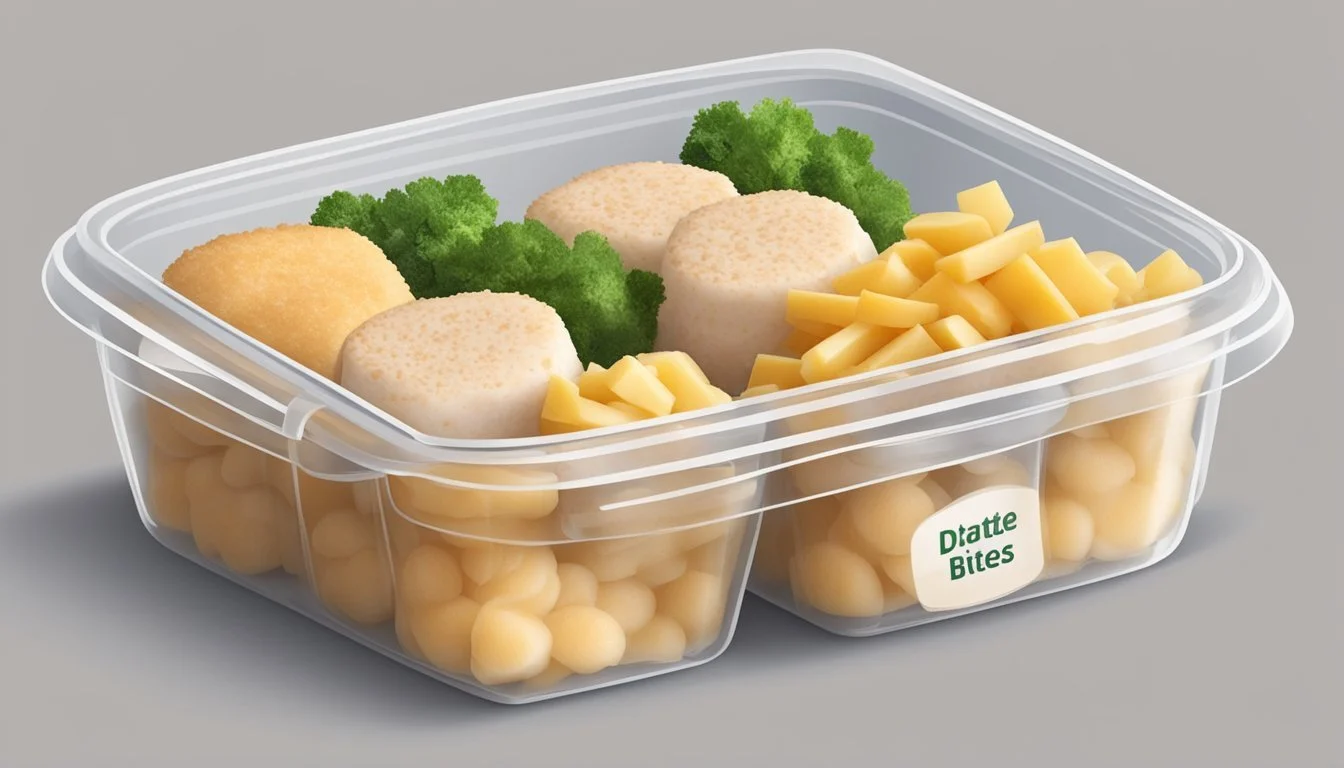How Long Do Chicken Cordon Bleu Bites Last?
Shelf Life and Storage Tips
Chicken Cordon Bleu Bites are a delightful and savory appetizer that blends the flavors of tender chicken, ham, and cheese into small, bite-sized portions. These flavorful bites are perfect for parties, snacks, or even as a main dish.
When stored properly in an airtight container in the refrigerator, Chicken Cordon Bleu Bites can last for up to three to four days. This ensures they retain their flavor and remain safe to eat. For longer storage, they can be frozen for up to two months.
Knowing the shelf life of these bites can help in meal planning and preparation for events or weekly meals. Whether reheating from the fridge or enjoying fresh out of the oven, Chicken Cordon Bleu Bites are a versatile and convenient option.
Overview of Chicken Cordon Bleu Bites
Chicken Cordon Bleu Bites are a popular appetizer featuring a medley of chicken, ham, and cheese. Known for their savory flavors and crispy texture, they are favored in various cuisines for their unique taste and presentation.
Historical Context
Chicken Cordon Bleu originated in Switzerland, with "cordon bleu" meaning "blue ribbon" in French. The traditional dish comprises flattened chicken breast, ham, and cheese, often Swiss. It is breaded and either fried or baked. Derived from this classic entree, Chicken Cordon Bleu Bites were created as a more manageable and appetizer-friendly version. These bites make the dish more accessible for parties and casual gatherings, keeping the flavors intact while simplifying the eating experience.
Characteristics
Chicken Cordon Bleu Bites typically consist of small, bite-sized pieces of chicken wrapped around a piece of ham and cheese. Swiss cheese is a common choice, but variations exist using cheddar or mozzarella. These bites are coated in breadcrumbs, adding a crispy layer when fried or baked.
They are usually served hot, retaining a gooey cheese center that contrasts with the savory ham and crispy chicken. As an appetizer, they are easy to pre-prepare and cook quickly, making them ideal for serving at social events. This miniature version retains the essential qualities of the classic dish while offering convenience and versatility.
Preparing Chicken Cordon Bleu Bites
Preparing Chicken Cordon Bleu Bites involves selecting the right ingredients, assembling the bites properly, and using suitable cooking techniques. Each step is crucial for achieving a delicious and satisfying result.
Choosing Ingredients
The main ingredients are chicken, ham, and cheese. Chicken breasts are ideal due to their tenderness and ease of handling. For the ham, options like deli ham, honey ham, or smoked ham provide different flavor profiles. Cheese choices can vary; Swiss cheese is traditional, but cheddar cheese might also be used for a richer taste.
Other important ingredients include flour, egg, bread crumbs, and spices like salt and pepper to enhance flavor. For added taste, consider using garlic powder and onion powder. These spices should align with the overall flavor profile you are aiming for.
Fresh ingredients are critical. Verify the freshness of the chicken, ham, and cheese before use. Using high-quality products leads to a superior dish.
Assembly Process
Cut the chicken breasts into bite-sized pieces. It ensures even cooking and easy consumption. Lay out the ham slices and cheese slices. Each bite should include a piece of chicken, a slice of ham, and a piece of cheese.
Coat the chicken pieces first in flour seasoned with salt and pepper, then dip them in beaten egg. This helps the bread crumbs adhere better. Finally, roll them in bread crumbs to create a crispy outer layer. Ensure each piece is evenly coated to prevent uneven cooking.
When assembling, place a small piece of ham and cheese on top of or around each chicken piece before rolling or securing with a toothpick. Proper assembly is key to ensuring that each bite contains all the flavors.
Cooking Techniques
There are various methods to cook the bites. Frying involves heating oil to about 350 degrees F (175 degrees C) in a deep skillet. Fry each bite until golden brown, approximately four minutes. Drain on paper towels to remove excess oil.
Baking is another method. Preheat the oven to 350 degrees F (175 degrees C). Place the bites on a baking sheet and cook until the chicken is fully cooked and the coating is crisp.
Each technique requires attention to cooking time and temperature to avoid overcooking. Optionally, serve them with a dijon mustard dipping sauce. This adds a tangy flavor that complements the bites perfectly, enhancing the tasting experience.
Cooking Instructions
Cooking Chicken Cordon Bleu Bites involves various methods like baking, frying, and using an air fryer. Each technique has its own steps to achieve the perfect crispiness, golden brown exterior, and ensure the chicken is cooked through.
Baking in the Oven
Preheat the oven to 350°F (175°C). Prepare a baking dish by spraying it with cooking spray or lining it with parchment paper.
Form the chicken mixture into 2-inch balls and place them onto the prepared baking dish. Bake for about 20-25 minutes or until they're golden brown and the internal temperature reaches 165°F (75°C).
Make sure to let them cool slightly before serving. Flipping halfway through baking can ensure even cooking.
Frying Methods
Heat 1.5 inches of oil in a deep skillet to 350°F (175°C). Carefully place the chicken bites into the hot oil using tongs to prevent splashing.
Fry for approximately 4-5 minutes until the bites are golden brown. Place them on paper towels to drain excess oil.
After frying, you can also place them in a preheated oven at 350°F for 5-10 minutes to ensure they are cooked through. This step gives a crispy texture and ensures food safety.
Using an Air Fryer
Preheat the air fryer to 375°F (190°C). Lightly spray the basket with cooking spray to prevent sticking.
Arrange the chicken bites in a single layer, ensuring they do not touch. Cook for 10-12 minutes, shaking the basket halfway through the cooking time.
This ensures they become crispy and golden brown. Check the internal temperature to make sure it reaches 165°F (75°C), indicating that the chicken is cooked through.
Food Safety and Storage
Properly handling and storing Chicken Cordon Bleu Bites is essential to maintain their taste and safety. This involves appropriate cooling techniques, optimal refrigeration, and effective freezing and thawing practices.
Cooling and Storing
After cooking, Chicken Cordon Bleu Bites should be cooled rapidly to prevent bacterial growth. Place them on a plate lined with paper towels to absorb excess grease.
Once cooled, store them in airtight containers. Store containers in a single layer to allow even cooling.
Ensure they are placed in the refrigerator within two hours after cooking. If left out longer, food safety is compromised.
Refrigeration Lifespan
In the refrigerator, Chicken Cordon Bleu Bites can last 3 to 4 days.
Keep them at a temperature below 40°F (4°C) to ensure safety. Use a food thermometer to check the fridge temperature regularly.
Label containers with the date they were stored to keep track of their freshness.
Avoid placing hot items directly in the fridge as it can raise the internal temperature.
Freezing and Thawing
For longer storage, Chicken Cordon Bleu Bites can be frozen. Place them on a baking sheet in a single layer, freeze until solid, and then transfer to freezer bags.
When ready to eat, thaw the bites in the fridge overnight, not at room temperature.
To reheat, use either an oven or air fryer to preserve their crispy texture. Avoid microwaving, as it can make them soggy.
Freezing helps extend their lifespan up to 3 months while retaining quality. Ensure they are tightly sealed to prevent freezer burn.
By following these guidelines, one can enjoy Chicken Cordon Bleu Bites safely and deliciously beyond the initial serving.
Serving Suggestions
Serve Chicken Cordon Bleu Bites in a way that is both visually appealing and appetizing. Pair them with complementary sides and sauces to create a delightful meal experience for your guests.
Presentation Ideas
Making the bites visually appealing enhances the dining experience. Arrange them neatly on a large platter for an inviting display at parties or gatherings.
Use toothpicks or skewers to serve individual bites, making it easy for guests to pick them up. These can also be color-coordinated for a festive touch. Place the bites on decorative plates or trays, adding garnish like fresh parsley or cherry tomatoes for an added splash of color.
Consider serving the bites with a variety of small dipping bowls filled with different sauces, such as honey mustard, garlic aioli, or marinara. This not only looks attractive but also allows guests to choose their favorite flavors.
Pairings and Accompaniments
Chicken Cordon Bleu Bites can be paired with a variety of sides to complete the meal. A fresh garden salad with a light vinaigrette works well, adding a crisp and refreshing contrast to the rich flavors of the bites.
For a heartier option, consider serving the bites alongside rice pilaf or mashed potatoes. These sides are both easy to prepare and complement the taste of the chicken bites.
Add variety to the plate with seasonal vegetables such as steamed broccoli, roasted carrots, or a medley of grilled bell peppers. This not only enhances the taste but also adds nutritional value to the meal.
Bread rolls or crusty baguettes can be provided to round out the offering, giving guests something extra to soak up any delicious sauces.
Nutritional Information
Chicken Cordon Bleu Bites offer a tasty yet rich option for many meals. The nutrition can vary based on ingredients and preparation methods.
A typical serving size of 3-4 bites can average around 300-350 calories. These bites combine chicken, ham, and cheese, providing a balanced profile of fats, proteins, and carbohydrates.
Nutrient Amount per Serving (approx.) Calories 300-350 Protein 25g Fat 18g Carbohydrates 15g Fiber 1g Sodium 800mg
Protein content is substantial, mainly from the chicken and ham, offering about 25 grams per serving. This can support muscle repair and growth.
Fat content is moderate, with around 18 grams per serving. Much of this originates from the cheese and any oil used during frying. Pay attention to this if managing fat intake.
Carbohydrates contribute about 15 grams per serving, often due to breading. Adjustments to breading can be made for specific dietary needs.
For dietary information, these bites contain dairy, which is important for those with lactose intolerance or dairy allergies. They also include gluten from breading, which may need modification for a gluten-free diet.
Counting sodium, the cheese and processed ham add a significant amount, around 800mg per serving. This is something to consider for those monitoring sodium levels.
Overall, Chicken Cordon Bleu Bites are a protein-rich option but should be consumed in moderation within a balanced diet.
Additional Tips and Tricks
To get the best results and maximum shelf life from your chicken cordon bleu bites, it’s crucial to consider a few key elements. This includes preparing the bites ahead of time, preserving their quality, and avoiding common mistakes.
Making Ahead of Time
Preparing chicken cordon bleu bites ahead of time can save you a lot of hassle. After assembling the bites, they can be refrigerated for up to one day before cooking. This allows flavors to meld together, ensuring a more flavorful dish.
When refrigeration is needed for more than a day, it's better to freeze the bites. Place them on a baking sheet to freeze individually, then store them in an airtight container. Chicken cordon bleu bites can be frozen for up to three months.
To cook from frozen, add an extra 5-10 minutes to the baking time, always ensuring the internal temperature reaches 165°F. This avoids undercooking and ensures food safety.
Ensuring Quality
Maintaining the quality of chicken cordon bleu bites involves several steps. Proper storing methods are essential. If refrigerating, always use a sealed container to avoid contamination and flavor absorption from other foods.
Reheat the bites gently. Use an oven rather than a microwave to retain crispiness and prevent sogginess. Preheat the oven to 350°F and reheat for about 10-15 minutes until warmed through.
When making the recipe, use fresh ingredients. Quality ham and cheese will make a noticeable difference in flavor. Pay attention to breading; ensuring it's evenly coated and cooked to a golden brown can significantly affect the final outcome.
Common Mistakes to Avoid
Avoid overstuffing the chicken as this can lead to uneven cooking and messy presentation. Ensuring the filling is appropriate for the size of the chicken piece is key.
Cook the bites at the correct temperature. Too high, and the outside may burn before the inside is cooked. Too low, and they might become soggy. Follow the recommended cook time of 25-30 minutes at 375°F for the best results.
Another common mistake is neglecting to check the internal temperature. Always use a food thermometer to ensure the chicken reaches 165°F, guaranteeing it's safe to eat.
By taking these steps, you can extend the freshness and overall enjoyability of your chicken cordon bleu bites.
Conclusion
When stored properly, Chicken Cordon Bleu Bites can last in the refrigerator for up to 3-4 days. It is essential to store them in an airtight container to maintain freshness.
For longer storage, these bites can be frozen for up to 2 months. Wrap them tightly in aluminum foil or plastic wrap, then place them in a freezer-safe container or bag.
Reheating should be done with care to avoid overcooking. Use an oven or air fryer at a low temperature to ensure they stay crispy.
Inspect the Chicken Cordon Bleu Bites before consumption. If there's any off-odor, discoloration, or texture change, it is best to discard them. Proper food safety ensures that these bites remain a delicious treat.









